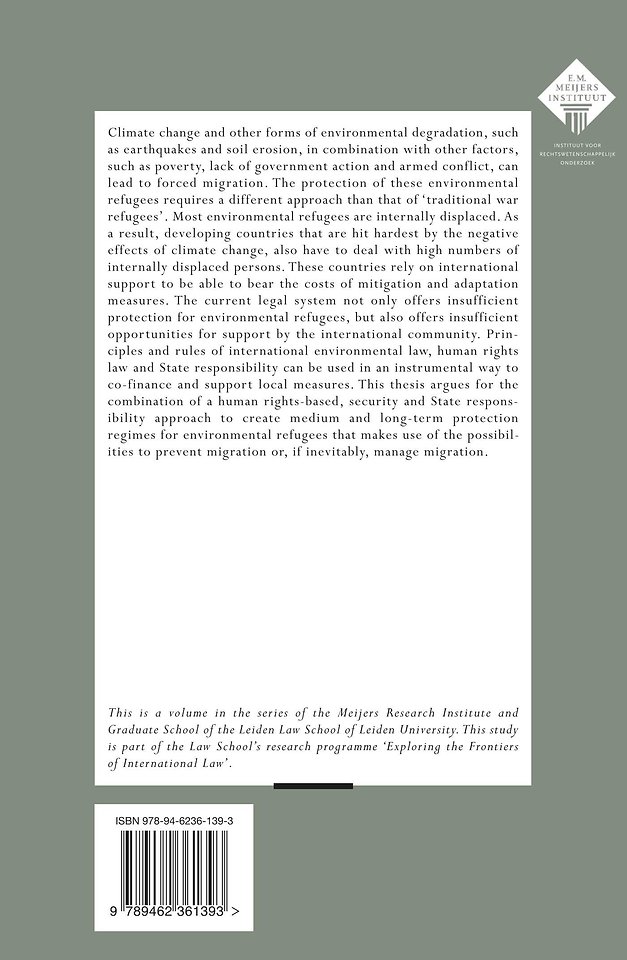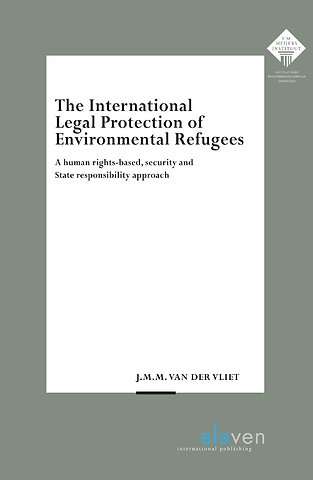The International Legal Protection of Environmental Refugees
A human rights-based, security and State responsibility approach
Samenvatting
Climate change and other forms of environmental degradation, such as earthquakes and soil erosion, in combination with other factors, such as poverty, lack of government action and armed conflict, can lead to forced migration. The protection of these environmental refugees requires a different approach than that of ‘traditional war refugees’.
Most environmental refugees are internally displaced. As a result, developing countries that are hit hardest by the negative effects of climate change, also have to deal with high numbers of internally displaced persons. These countries rely on international support to be able to bear the costs of mitigation and adaptation measures. The current legal system not only offers insufficient protection for environmental refugees, but also offers insufficient opportunities for support by the international community.
Principles and rules of international environmental law, human rights law and State responsibility can be used in an instrumental way to co-finance and support local measures. This thesis argues for the combination of a human rights-based, security and State responsibility approach to create medium and long-term protection regimes for environmental refugees that makes use of the possibilities to prevent migration or, if inevitably, manage migration.
Trefwoorden
Specificaties
Inhoudsopgave
1 INTRODUCTION 1
1.1 Objective of the study 2
1.1.1 Overall study objective 2
1.1.2 Basic premises of the study 3
1.1.3 Academic and societal contribution of the study 4
1.1.4 Added value of the study compared with existing research 4
1.2 Structure and research questions 6
1.3 Methodology 7
1.4 Scope and limitations 8
PART I – CONCEPTUALIZING ENVIRONMENTALLY FORCED MIGRATION 9
2 THE CONCEPT OF THE ENVIRONMENTAL REFUGEE 11
2.1 Framing the concept of environmental refugees 12
2.1.1 Early academic research 12
2.1.2 Acceptance of the concept by stakeholders 15
2.1.3 The scope of ratione personae and materiae 20
2.1.4 Working definition 26
2.2 Types of environmental refugees in this research 31
2.2.1 Sudden-onset disasters 33
2.2.2 Slow-onset disaster 35
2.2.3 Armed conflict 41
2.2.4 Environmental contamination 43
2.2.5 Planned resettlement 45
2.3 Approaches to environmental refugees 47
2.3.1 The rights-based approach 47
2.3.2 The security approach 48
2.3.3 The responsibility approach 51
2.4 Conclusion 52
PART II – THE INTERNATIONAL LAW FRAMEWORK 55
3 THE RIGHTS-BASED APPROACH 57
3.1 The human rights framework 57
3.1.1 General limitations of the human rights framework 60
3.1.2 Substantive rights 61
VI Table of contents
3.1.3 Procedural rights 92
3.1.4 Vulnerable groups 102
3.2 The Internally Displaced Persons framework 120
3.2.1 The Guiding Principles on Internally Displaced Persons 121
3.2.2 Inter-Agency Standing Committee Framework on Durable Solutions for Internally Displaced Persons 123
3.2.3 Regional regimes on IDP protection 124
4 SPECIFIC PROTECTION POSSIBILITIES FOR DIFFERENT TYPES OF ENVIRONMENTAL REFUGEES WITHIN THE RIGHTS-BASED APPROACH 129
4.1 Sudden-onset disasters 129
4.1.1 The human rights framework 129
4.1.2 The Internally Displaced Persons framework 135
4.1.3 Conclusion on sudden-onset disasters 138
4.2 Slow-onset disasters 139
4.2.1 The human rights framework 140
4.2.2 The Internally Displaced Persons framework 143
4.2.3 Loss of State territory and the legal framework 146
4.2.4 Conclusion on slow-onset disasters 149
4.3 Armed conflict 150
4.4 Environmental pollution 150
4.4.1 The human rights framework 150
4.4.2 The Internally Displaced Persons framework 155
4.5 Planned resettlement 156
4.5.1 Out of harm’s way 158
4.5.2 Development displacement 160
4.5.3 Forced evictions 164
4.5.4 Conclusion 165
5 THE SECURITY APPROACH 167
5.1 Cross-border migration 168
5.1.1 The Refugee Convention relating to the Status of Refugees 169
5.1.2 Regional refugee instruments 174
5.2 Complementary forms of protection 176
5.2.1 Non-refoulement 177
5.2.2 Other forms of complementary protection 189
5.2.3 Conclusion on cross-border migration 194
5.3 Internal migration 195
6 SPECIFIC PROTECTION POSSIBILITIES FOR DIFFERENT TYPES OF ENVIRONMENTAL REFUGEES WITHIN THE SECURITY APPROACH 199
6.1 Sudden-onset disasters 199
6.1.1 Refugee protection 199
6.1.2 Non-refoulement 201
6.1.3 Temporary protection 202
6.1.4 Internal migration 203
6.2 Slow-onset disasters 203
6.2.1 Refugee protection 203
6.2.2 Non-refoulement 204
6.2.3 Temporary protection 205
6.2.4 Internal migration 205
6.2.5 Low-lying small island States 206
6.3 Armed conflict 213
6.4 Environmental pollution 214
6.5 Planned resettlement 214
7 THE RESPONSIBILITY APPROACH 217
7.1 Responsibility under the climate regime 218
7.1.1 Human mobility in the climate change negotiations 225
7.2 Responsibility under the UN Convention on the Law of the Sea 230
7.3 Responsibility under international human rights law 234
7.4 Responsibility under general principles of public international law 241
7.4.1 The ‘no-harm’ principle 242
7.4.2 The precautionary principle 255
7.4.3 The polluter pays principle 258
7.4.4 The principle of common but differentiated responsibilities 260
7.4.5 Transparency, public participation and access to information and remedies 264
7.5 Invoking State responsibility 267
7.5.1 Forum and standing 269
7.5.2 Damaging activity and attribution 274
7.5.3 Causation 275
7.5.4 Allocation of loss 283
7.6 The principle of sustainable development 291
7.6.1 The Sustainable Development Goals 296
8 SPECIFIC PROTECTION POSSIBILITIES FOR DIFFERENT TYPES OF ENVIRONMENTAL REFUGEES WITHIN THE RESPONSIBILITY APPROACH 299
8.1 Sudden-onset disasters 299
8.2 Slow-onset disasters 300
8.3 Armed conflict 301
8.4 Environmental contamination 301
8.5 Planned resettlement 303
9 GENERAL CONCLUSION ON THE LEGAL INTERNATIONAL FRAMEWORK 307
9.1 Conclusion on the rights-based approach 307
9.2 Conclusion on the security approach 308
9.3 Conclusion on the responsibility approach 309
PART III – CREATIVE INTERPRETATION AND EXTRAPOLATION 311
10 THE RIGHTS-BASED APPROACH 313
10.1 Right to a healthy environment 314
10.1.1 A freestanding right to a healthy environment 315
10.1.2 Substantial rights presupposing a healthy environment 316
10.1.3 Rights of nature 318
10.1.4 The environment as a public good within the context of economic and social rights 320
10.2 Procedural rights 321
10.2.1 Right to information 321
10.2.2 Right to public participation 322
10.2.3 Right to remedy 324
10.3 Positive extraterritorial State obligations 324
10.3.1 Transboundary harm 326
10.3.2 Duty of cooperation 331
10.3.3 R2P 337
10.4 Internally displaced persons 341
11 THE SECURITY APPROACH 343
11.1 The refugee framework 343
11.1.1 Broader interpretation of the Refugee framework 343
11.1.2 Extension of the Refugee Convention 348
11.1.3 The Global Compact on Refugees 350
11.2 The complementary protection framework 351
11.2.1 Non-refoulement 351
11.2.2 Temporary protection 356
11.2.3 Subsidiary protection 357
11.3 Voluntary migration 359
11.3.1 The Global Compact for Safe, Orderly and Regular Migration 360
11.4 Development of new instruments 362
11.4.1 Drafting a new convention 364
12 THE RESPONSIBILITY APPROACH 367
12.1 International Environmental law 368
12.2 Human rights 368
12.3 Responsibility 370
12.3.1 Loss and damage 372
12.3.2 Compensation funds 372
12.3.3 Insurance 375
PART IV – COMBINING APPROACHES 377
13 OVERLAPPING APPROACHES 379
13.1 The rights-based and security approach 381
13.2 The rights-based and responsibility approach 384
13.2.1 Justice 389
13.3 The security and responsibility approach 394
14 A CONTEXT-ORIENTED AND DYNAMIC INTERPRETATION FOR DIFFERENT TYPES OF ENVIRONMENTAL REFUGEES 397
14.1 Sudden onset disasters 398
14.2 Slow-onset disasters 400
14.3 Armed conflict 402
14.4 Environmental contamination 403
14.5 Planned resettlement 404
15 GENERAL CONCLUSION 405
BIBLIOGRAPHY 417
TABLE OF TREATIES 437
TABLE OF CASES 449
Anderen die dit e-book kochten, kochten ook
Net verschenen
Rubrieken
- aanbestedingsrecht
- aansprakelijkheids- en verzekeringsrecht
- accountancy
- algemeen juridisch
- arbeidsrecht
- bank- en effectenrecht
- bestuursrecht
- bouwrecht
- burgerlijk recht en procesrecht
- europees-internationaal recht
- fiscaal recht
- gezondheidsrecht
- insolventierecht
- intellectuele eigendom en ict-recht
- management
- mens en maatschappij
- milieu- en omgevingsrecht
- notarieel recht
- ondernemingsrecht
- pensioenrecht
- personen- en familierecht
- sociale zekerheidsrecht
- staatsrecht
- strafrecht en criminologie
- vastgoed- en huurrecht
- vreemdelingenrecht









